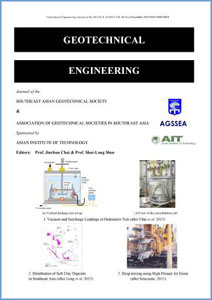Design Method for Bearing Reinforcement Earth Wall
Main Article Content
Abstract
The bearing reinforcement was developed as a cost-effective earth reinforcement. It is composed of a longitudinal member and transverse members. The longitudinal member is made of a deformed bar, which exhibits a high pullout friction resistance. The transverse members are a set of equal angles, which provide high pullout bearing resistance. The bearing reinforcement earth (BRE) walls have been applied as a bridge abutment and a retaining structure along mountainous areas in several projects of the Department of Highways, Thailand since 2008. Based on the laboratory and field studies and design experience, the design method of the BRE wall is presented. The examination of external stability is performed using the conventional method (limit equilibrium analysis) assuming that the composite backfill-reinforcement mass behaves as a rigid body. The internal stability deals with rupture and pullout resistances of the reinforcement. The pullout resistance of the bearing reinforcement is approximated using the modified punching shear mechanism. The maximum tension plane is the bilinear failure mechanism (coherent gravity structure hypothesis). Finally, a design procedure, which commonly used in Thailand, is summarized and suggested.
Article Details

This work is licensed under a Creative Commons Attribution-NonCommercial-NoDerivatives 4.0 International License.
Copyright © 2019 Association of Geotechnical Societies in Southeast Asia (AGSSEA) - Southeast Asian Geotechnical Society (SEAGS).


